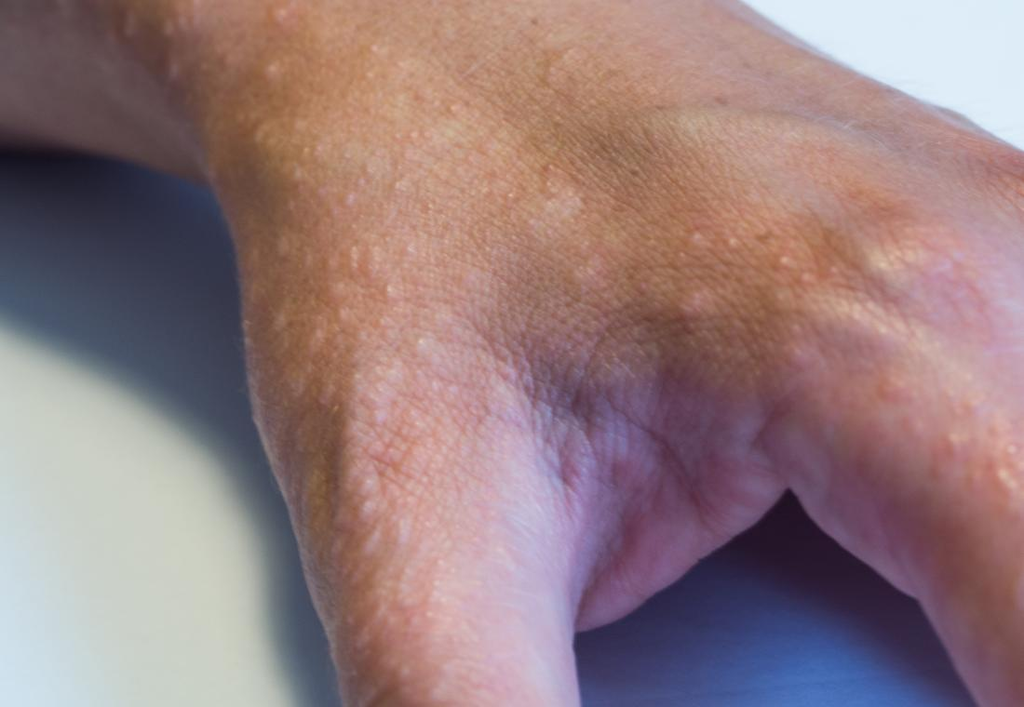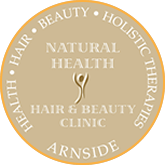Eczema (also known as dermatitis) is the name for a group of skin conditions which cause inflammatory dry skin.
Eczema (also known as dermatitis) is the name for a group of skin conditions which cause inflammatory dry skin. It can affect people from early infancy to old age. The most common form, atopic eczema, affects 1 in 5 children and 1 in 10 adults in the UK.
The skin is often unbearably itchy – the urge to scratch can be irresistible – and during a flare-up it can also be red, cracked, sore and raw. Alongside the painful physical symptoms, many children and adults experience related sleeplessness, anxiety, depression and other mental health problems.
Eczema is not contagious. You can’t “catch it” from someone else. While the exact cause of eczema is unknown, researchers do know that people who develop eczema do so because of a combination of genes and environmental triggers.
When an irritant or an allergen from outside or inside the body “switches on” the immune system, it produces inflammation. It is this inflammation that causes the symptoms common to most types of eczema.
There are several different types of eczema.
It is possible to have more than one type of eczema on your body at the same time. Each form of eczema has its own set of triggers and treatment requirements, which is why it’s so important to consult with a Healthcare provider. Dermatologists in particular can help identify which type or types of eczema you may have and how to treat and prevent flare-ups.
This blog focuses on:
Atopic dermatitis
Contact dermatitis
Neurodermatitis
Dyshidrotic eczema
Nummular eczema
Atopic Dermatitis
Atopic dermatitis (AD) the most common type of eczema, is a chronic condition that can come and go for years or throughout life, and can overlap with other types of eczema.

In people with AD, for complex reasons science hasn’t fully sorted out, the immune system becomes disordered and overactive. This triggers inflammation that damages the skin barrier, leaving it dry and prone to itching and rashes that may appear purple, brown or grayish hue in darker skin tones and red in lighter skin tones.
Research shows that some people with eczema, especially atopic dermatitis, have a mutation of the gene responsible for creating filaggrin. Filaggrin is a protein that helps our bodies maintain a healthy, protective barrier on the very top layer of the skin. Without enough filaggrin to build a strong skin barrier, moisture can escape and bacteria, viruses and more can enter. This is why many people with AD have very dry and infection-prone skin.
Who gets AD and why?
Atopic dermatitis typically begins in childhood, usually in the first six months of a baby’s life. Even though it’s a common form of eczema, it’s also severe and long-lasting. When you or your child have atopic dermatitis, it may improve at times; but at other times, it may get worse. In some children, symptoms may taper off as they grow up, while other children will have atopic dermatitis flares into adulthood.
Atopic dermatitis exists with two other allergic conditions: asthma and hay fever (allergic rhinitis). People who have asthma and/or hay fever or who have family members who do, are more likely to develop AD.
What are the symptoms of AD?
Atopic dermatitis (eczema) signs and symptoms vary widely from person to person and include:
- Dry skin
- Itching, which may be severe, especially at night
- Red to brownish-gray patches, especially on the hands, feet, ankles, wrists, neck, upper chest, eyelids, inside the bend of the elbows and knees, and in infants, the face and scalp
- Small, raised bumps, which may leak fluid and crust over when scratched
- Thickened, cracked, scaly skin
- Raw, sensitive, swollen skin from scratching
Itching is the hallmark of AD, with some data showing that more than 85% of people with the condition experience this distressing symptom every day. Sore or painful skin and poor sleep caused by itching are also common.
People with AD can get rashes anywhere on the body that can ooze, weep fluid and bleed when scratched, making skin vulnerable to infection. Skin can become dry and discolored, and repeated scratching can cause thickening and hardening — a process called lichenification.
How is AD treated?
When AD is mild, management may include:
- Avoiding known triggers
- Maintaining a regular bathing and moisturizing routine to protect and strengthen the skin barrier
- getting high-quality sleep
- Eating a healthy diet
- Managing stress
If these methods are not enough, other treatments include:
Topical corticosteroids
Non-steroidal topicals
Biologics
Contact Dermatitis
Contact dermatitis happens when the skin becomes irritated or inflamed after coming in contact with a substance that triggers an allergic reaction.

It bears some of the same symptoms as the six other types of eczema. But unlike atopic dermatitis — the most common and difficult-to-treat form of eczema — it doesn’t run in families and isn’t linked to other allergic conditions such as hay fever or asthma.
There are two main types of contact dermatitis: irritant and allergic.
Irritant contact dermatitis, which accounts for 80% of all contact dermatitis, doesn’t involve an allergic reaction by the immune system. Instead, it happens when skin cells are damaged by exposure to irritating substances, such as solvents, detergents, soaps, bleach or nickel-containing jewelry. Makeup, hair dye, nickel-containing scissors, belt buckles or clothes with metal snaps or zippers can also trigger reactions — as can over-washing hands with hot water and soap and wearing scratchy wool.
Allergic contact dermatitis is a delayed allergic reaction that appears as a rash a day or two after skin is exposed to an allergen. A common example is poison ivy. After exposure, the body generates a robust inflammatory reaction to the oils in the plant leading to an itchy rash within one to two days. Fragrances, nickel and the preservative thimerosal, which is found in some topical antibiotics, are also common causes of allergic contact dermatitis.
Who gets contact dermatitis and why?
Irritant contact dermatitis is common in people whose professions involve daily use of chemicals, such as mechanics, custodians, healthcare workers or hairstylists.
What are the symptoms of contact dermatitis?
In addition to itch, contact dermatitis may cause burning or blistering of the skin, and can have a major impact on a person’s quality of life, including sleep disturbances, difficulty concentrating or performing duties at work and in school.
How is contact dermatitis treated?
Dermatologists commonly prescribe steroids to treat symptoms of contact dermatitis, which can mimic several other skin conditions. It’s important to see a board-certified dermatologist to rule out other conditions.
Topical steroids may resolve itching and other contact dermatitis symptoms, but if the rash is widespread, dermatologists may prescribe a short-term course of oral or injectable corticosteroids.
Preventing future outbreaks depends on pinpointing—and then avoiding—the irritant or allergen that triggers flares.
With irritant contact dermatitis, the trigger is usually easy to identify, as stinging, pain or discomfort usually happens within minutes of contact.
For allergic contact dermatitis, knowing what to avoid often requires an in-office procedure called patch testing. This is when the doctor applies patches with small amounts of various allergens to the patient’s arm or back and then evaluates skin after about 48 hours.
Dyshidrotic eczema causes small, intensely itchy blisters on the palms of hands, soles of feet and edges of the fingers and toes.

While the actual cause of dyshidrotic eczema isn’t known, it is more common in people who have another form of eczema and tends to run in families, suggesting a genetic component.
Who gets dyshidrotic eczema and why?
This common form of eczema, also called pompholyx (which means “bubble” in ancient Greek), foot-and-hand eczema, palmoplantar eczema and vesicular eczema, is found more frequently in women than in men.
Dyshidrotic eczema is most common in younger adults, typically between the ages of 20 and 40. People can have a single flare-up of dyshidrotic eczema, but it’s more common for it to come and go over long periods of time.
Metals, particularly nickel, are a common trigger. Stress can also cause a flare. The condition is also linked to seasonal allergies like hay fever, and to hot, humid weather. Sweaty palms can trigger the rash, as can doing a job such as hairstyling or healthcare that entails frequently getting the hands wet.
What are the symptoms of dyshidrotic eczema?
Flares happen only on the hands and feet and usually begin with a rash of painful, deep-seated blisters called vesicles, although sometimes itching and burning sensations begin first. As blisters heal, the skin dries and often reddens and peels. This leaves it tender and dry and sometimes creates painful fissures or cracks. Skin can also become infected.
How is dyshidrotic eczema treated?
Knowing your triggers and maintaining a regular skincare routine can help prevent and manage dyshidrotic eczema flares. Helpful steps can include:
- Wash the affected skin with a mild cleanser and gently pat dry.
- Apply a heavy cream with ingredients like ceramides to help repair the skin barrier.
- Remove rings and other jewelry when you wash your hands so water doesn’t linger on you skin.
- Wash then moisturize hands or feet immediately after coming into contact with a potential trigger.
- Use stress management techniques.
- Keep fingernails short to help prevent scratching from breaking the skin.
Dermatologists can usually diagnose dyshidrotic eczema with a skin exam and medical history. Many cases improve quickly with a short course of topical corticosteroids combined with soaking or applying cool compresses to affected areas a few times a day to help dry out blisters. Because this form of eczema is sometimes linked to a fungal infection on the hands or feet, your dermatologist may prescribe an anti-fungal medication if needed.
Areas of dyshidrotic eczema are also at risk for bacterial skin infections, which can delay or prevent healing. If you develop swelling, crusting, pain or pus-filled blisters, visit your dermatologist to check for bacterial infection, which requires treatment with oral antibiotics.
When dyshidrotic eczema is severe or flares happen often, dermatologists may prescribe light therapy, topical calcineurin inhibitors (TCIs) or oral steroids. Occasionally, botulinum toxin injections are used to control the sweaty hands and feet that can trigger the condition.
Neurodermatitis? 
Intense itching — and the scratching it causes — lead to the symptoms of neurodermatitis, a common type of eczema that affects about
12% of the population. Unlike atopic dermatitis, which can be widespread, neurodermitis is usually confined to one or two patches of skin. It rarely goes away without treatment, and continued scratching can irritate nerve endings in skin, intensifying both itching and scratching.
“Extremely itchy patches of skin cause patients to scratch even when they don’t realize it, and just telling them to stop isn’t realistic,” said Dr. Gil Yosipovitch, professor and director of the Miami Itch Center at the Dr. Phillip Frost Department of Dermatology and Cutaneous Surgery at the University of Miami Miller School of Medicine in Florida. Yosipovitch, who has used brain imaging to study the urge to scratch in patients with chronic itching, explained that scraping at the skin lights up the brain’s reward center. “In some sense, scratching is pleasurable, not that you want to do it, but that it provides relief and satisfaction,” he said. “This helps explain why it can become a habit that often happens unconsciously, and why this itch-scratch cycle is hard to break.” over time, chronic scratching causes itchy patches of skin to become dry, leathery and thickened. This is called lichenification, and neurodermatitis is also known as lichen simplex chronicus.
Symptoms of neurodermatitis
Neurodermatitis can occur anywhere you can reach to scratch, but is most common on the feet, ankles, hands, wrists, elbows, shoulders, neck and scalp. The eyelids can also be affected, as can genital and anal areas.
Itching can come and go or be active all the time. People often feel itchiest when they’re relaxing or trying to sleep, or when they’re stressed or anxious.
Thick, leathery patches of neurodermatitis can develop pronounced skin lines, scales and discoloration that’s often red, brown or gray. Scratching can cause open wounds that bleed, infection, scabbing and scarring. Over time, scratching scalp patches can cause hair loss.
Quality of life can also suffer, and itching can disrupt sleep and interfere with sexual function.
Who gets neurodermatitis and why?
Neurodermatitis is most common in adults between 30 and 50 years of age and occurs more often in women and people with contact dermatitis and atopic dermatitis. It’s rarely diagnosed in children, although a few with atopic dermatitis also develop neurodermatitis.
Psoriasis and anxiety disorders increase risk. “Research and clinical experience suggest certain personality types are more prone to developing neurodermatitis,” said Yosipovitch. “These include having stronger tendencies to conform or be a ‘people pleaser,’ to hold in emotions, or to be excessively dutiful.”
Neurodermatitis can also be triggered by tight clothing (particularly when made from wool or synthetic fabric), bug bites, nerve injury and dry skin.
Treating neurodermatitis
Treatment for neurodermatitis is aimed at healing skin and ending the itch-scratch cycle.
Dermatologists often use corticosteroids to help calm inflammation and itch and soften thickened skin. These are usually potent topical steroids, but if the skin is very thick, your dermatologist may inject a steroid into the patch.
Non-steroidal topicals such as calcineurin inhibitors and ointments made with salicylic acid can also be used to control itch.
Occlusive treatments that cover the affected area can help control itching and make it harder to scratch. These include applying plastic wrap after putting on topicals or moisturizer or using gauze treated with zinc oxide paste.
Dermatologists may also prescribe medicated patches that contain lidocaine, a numbing agent, and capsaicin, a chili pepper component that helps desensitize the nerve endings causing itching.
Some oral medications can also help stop the urge to scratch, particularly when it happens during sleep. These include prescription antihistamines, which can cause drowsiness, and low doses of anti-anxiety medications.
Certain patients may benefit from counseling or cognitive behavioral therapy to help address anxiety and other emotional issues contributing to the itch-scratch cycle.
Relaxation techniques such as progressive muscle relaxation, yoga and mindfulness practices can also help curb scratching.
Moisturizing daily, cool compresses or baths with colloidal oatmeal, and wearing loose-fitting, non-irritating clothing can relieve itching, while keeping fingernails short limits damage caused by scratching.
What is nummular eczema?
Nummular eczema, also known as discoid eczema and nummular dermatitis, features scattered circular, often itchy and sometimes oozing patches.

The word “nummular” comes from the Latin word for “coin,” as the spots can look coin-shaped on the skin.
Who gets nummular eczema and why?
Nummular eczema can occur at any age, and males tend to develop it more often than females.
Its causes aren’t clear, but triggers can include very dry or sensitive skin and trauma to the skin from insect bites, scrapes or chemical burns.
Nummular eczema may also develop as a reaction to some other types of eczema and their triggers, such as contact dermatitis and nickel. When it appears on the legs, it can be linked to poor blood flow in the lower body and the stasis dermatitis those circulation problems can cause.
What are the symptoms of nummular eczema?
symptoms of nummular eczema can include:
- coin-shaped lesions on arms, legs, torso and/or hands
- itching and burning
- lesions that are oozing liquid or have crusted over
- red, pinkish or brown, scaly and inflamed skin around the lesions
How is nummular eczema treated?
Nummular eczema can look like psoriasis, ringworm, fungal infection and other types of eczema, including atopic dermatitis, stasis dermatitis and contact dermatitis. It can also occur along with those types of eczema, though it often appears as an isolated condition. Dermatologists can usually spot the condition but may take a skin scraping to confirm a diagnosis.
Once correctly diagnosed, nummular eczema tends to disappear completely with the right treatment. However, unlike some other forms of eczema, nummular seldom improves without relatively aggressive treatment.
Like atopic dermatitis, patches of nummular eczema are often infected with Staphylococcus aureus (staph), which needs to be treated along with the skin inflammation to clear the condition.
Nummular eczema can be treated with a mid- or high-potency topical corticosteroid, along with a topical antibiotic. If eczema patches are substantially weepy and oozy, application of an astringent compress can help dry the area and drive out any staph infection.
How BioMed can help
BioMed takes a total body (and mind) approach in supporting and restoring the body’s bioregulating systems’ ability to regenerate, repair, and self-heal through the use of natural and energetic therapies. This is especially important in the treatment and management of a chronic condition such as eczema and related symptoms.
A personalised Health Care Plan can be formulated to keep your eczema symptoms to a minimum whilst optimising your general health and well being. Bioregulatory remedies have been shown to be particularly effective in speedily reducing the symptoms if an eczema flare up should occur.
Please CONTACT US for a consultation if you have concerns about eczema or any other health condition.

